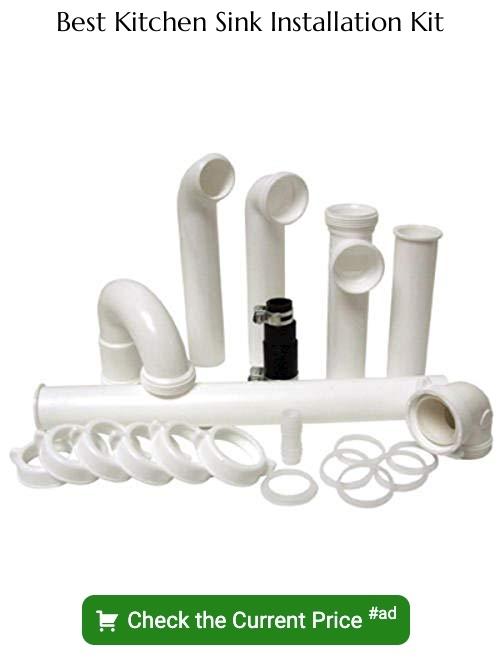Last updated on
This guide will lead you step-by-step through the process of installing a kitchen sink, making sure your kitchen is ready for all your cooking and cleaning needs.
Key takeaways:
- Disconnect and remove the old sink with caution.
- Measure the countertop opening accurately and consider professional help if needed.
- Install the new sink carefully, following the instructions provided.
- Reassemble and connect the faucet, drains, and other components properly.
- Finalize the installation by checking for leaks and applying caulk.
What's Inside
Disconnect and Remove the Old Sink

Begin by turning off the water supply valves located beneath the sink to prevent any accidental water spillage. Next, disconnect the water supply lines using an adjustable wrench; keep a bucket handy for any water that may escape.
Proceed to detach the drain pipes. A pipe wrench will help you loosen the slip nuts. Remember to clear out any water left in the P-trap – the curved pipe under the sink, before you remove it.
If you have a garbage disposal unit installed, now’s the time to take it out. Unplug the unit and disconnect it from the drain. This might require a screwdriver to release the mounting bracket holding it in place.
With the plumbing disconnected, the next step is to free the sink from the countertop. Many sinks are sealed with caulk or plumber’s putty, so you’ll need to cut through this sealant with a utility knife to break the seal.
Once the perimeter is clear, check for clips or brackets that hold the sink in place from below. Loosen these with a screwdriver.
Finally, with a gentle push from below, lift the sink out of the countertop space. If it’s a heavier sink, like those made from cast iron or stone, you might need an extra pair of hands to safely remove it without causing any damage.
Measure the Countertop Opening
Getting the right fit is crucial when you’re installing a sink. Start by double-checking the manufacturer’s specifications for the required opening. Use a tape measure to determine the length and width of the current countertop opening, jotting down the dimensions. If your new sink is larger, you’ll need to enlarge the opening—mark out the cutting lines with painter’s tape to protect the countertop and guide your saw.
Remember to leave enough room for the sink’s lip, which typically needs about an inch of space on all sides for proper support. Verify the distance to the backsplash or any impediments to ensure the sink won’t interfere once installed. If your countertop material is particularly delicate or expensive, like granite or marble, consider hiring a professional to make the cuts. Precision now will save you headaches later.
Install the New Sink
Once your old sink is out and your new sink measurements align with the countertop opening, it’s time to fit the sink into place. Apply a bead of plumber’s putty around the edge of the sink to ensure a watertight seal. If your sink is a drop-in type, you can simply lower it into the countertop hole. Press down firmly but gently to set it in place.
Undermount sinks require a slightly different approach. You’ll need to apply a silicone adhesive to the rim of the undermount sink and then raise it to meet the underside of the countertop. It’s crucial to secure the sink with clips and fasteners, which should be included with the sink or available from the manufacturer.
For both types of sinks, ensure that the sink is perfectly aligned and level. You can use a level to check—it’s a simple tool that can save you from any unevenness issues later on. It’s also a good moment to attach any additional components that come with the sink, like pre-mounted hardware or soap dispensers.
If your new sink has holes for faucets or accessories, make sure these align with the items you plan to install. You don’t want to secure the sink into place only to find out later that something doesn’t fit. With everything in place, clean off any excess putty or adhesive for a neat finish before moving on to reassembling and connecting the plumbing fixtures.
Reassemble and Connect
Having your new sink perfectly set in place, the next step is to reassemble the faucet, drains, and other necessary components before connecting them. Begin by securing the faucet onto the sink. If your sink includes pre-drilled holes, align the faucet’s base plate and thread the connectors through the holes, tightening the mounting nuts beneath.
Turning your attention to the drain, apply plumber’s putty to the underside of the drain flange and press it firmly into the sink’s drain hole. Attach the drain’s gasket and threading on the locknut beneath the sink, ensuring a snug fit. Wipe away any excess putty that squeezes out.
For sinks with garbage disposals, you’ll mount the disposal unit according to the manufacturer’s instructions, making sure to align it properly with the drain assembly.
Next, connect the water supply lines to the corresponding hot and cold valves, taking care not to cross threads. Tighten these connections with adjustable wrenches, but avoid overtightening which can cause damage.
Finally, reattach the P-trap to the drain tailpiece, usually hand-tightening the slip nuts will suffice. If you have a dishwasher, don’t forget to hook up the dishwasher drain line too. Once all connections are secure, turn on the water and check for leaks, tightening any connections if necessary to ensure everything is watertight.
Finalize the Installation
Now that your sink is set in place and the plumbing is connected, it’s time to dot the i’s and cross the t’s. First, check for leaks by running water and observing connections for any drips—tighten fittings if necessary.
Next, apply a bead of silicone caulk around the perimeter of the sink to create a watertight seal between the sink and countertop. This step prevents water from seeping underneath, which could cause damage over time. Allow the caulk to cure as directed by the manufacturer.
After sealing, reattach any accessories, such as a soap dispenser or spray nozzle. Confirm that the sink’s alignment is perfect and make any required adjustments. For a smooth experience, ensure the sink operates properly by testing the drain and watching the water flow seamlessly.
Cleaning up excess caulk or debris from the installation will give your new sink a flawless finish. Your diligence here sets the stage for a reliable and functional kitchen sink that will serve you well for meals, cleanup, and daily routines.





